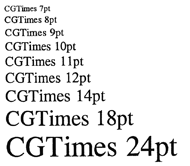Attributes of Fonts
All fonts share some common characteristics, which are called attributes. The typeface is one such attribute. The letters and symbols that are actually printed are determined by the values of a collection of these attributes.
|
Typeface
|
The design of the letters (e.g., Courier, CG Times, Helvetica, or Gothic).
|
|
Stroke Weight
|
The thickness of the lines with which the letters are drawn (e.g., bold, medium, or light).
|
|
Style
|
Whether the letters are drawn straight or at an angle (e.g., upright or italic).
|
|
Point Size
|
Height of the letters (e.g., 10 point or 5 point).
|
|
Pitch (cpi)
|
Number of characters that are printed in one inch (e.g., 10 cpi, 12 cpi, or Scale).
|
|
Character Width (Fixed/PS)
|
Indicates whether the character width is set to Fixed or Proportional.
|
|
Orientation
|
Orientation of the characters on a page (Portrait or Landscape).
|
|
Symbol Set
|
The rule that defines the correspondence between the character codes coming from the host computer, and the letter forms that appear on the page (e.g., Roman-8).
|
Typeface
Typeface refers to the design of the characters and symbols. The following figure shows an example of some typefaces.

Stroke Weight
Stroke weight refers to the thickness of the print. There are light, medium, and bold stroke weights. The printer function has medium and bold fonts available. The figure below shows an example of medium and bold printing.

Style
Style refers to the shape of the characters. The printer function can print in two styles: upright and italic.
With some fonts, like CourierPS and Letter Gothic, the terms Oblique and Slanted are used in the same manner as italics.

Point Size
Point size refers to the height of the character. Character size is measured in points. One inch is divided into 72 points and 1 point is 1/72 of an inch (about 0.35 mm). The printer function has bitmapped fonts and scalable fonts available. The bitmapped fonts are fixed in size, but the scalable fonts are not fixed in size. Scalable fonts are freely scalable to any size you wish in 0.1 point increments. The following figure shows an example of various point sizes.
For more information on bitmapped fonts and scalable fonts, see "Fonts and Scalable Fonts."

Pitch (cpi)
Pitch refers to the number of characters that are printed in one inch. The unit is cpi (characters per inch). As the number of characters per inch increases, the space between characters decreases; as the cpi decreases, the space between characters increases.

Character Width (Fixed and PS)
Each character has a different width from all the other characters in a font at a given point size. For example, W is a wider letter than I. There are two ways to print letters of different widths: you can print all letters with the same spacing, regardless of their actual width; or you can change the spacing between letters to accommodate these different widths. Printing all letters with the same spacing is called Fixed spacing, while changing the spacing to accommodate different letter widths is called Proportional spacing.
Because the Fixed spacing method prints all letters with the same spacing, the number of characters which will fit into a given length is a fixed quantity which can be specified.
If the characters are printed with Proportional spacing, then the number of characters that will fit into an inch varies depending on the letters printed.

Orientation
Orientation refers to the direction of printing. The printer function can print using two different paper orientations: portrait and landscape. With portrait orientation, text is printed across the width of the paper (short edge), and with landscape orientation, text is printed across the length of the paper (long edge).

Symbol Set
When you print the letter A, the host computer sends a code corresponding to A (hexadecimal 41 is an example of this) to the machine. This code is referred to as the character code. The machine stores an internal representation of each character, and selects from among these character patterns the pattern corresponding to the received code. In this case, the machine searches for the pattern for A, and prints it. The process by which letters are printed.
The machine uses a fixed rule to decide which letter or symbol corresponds to the character code sent from the host computer. For example, the letter A is printed for the hexadecimal code 41. The rule which determines the correspondence between character codes and printed letters is called the symbol set.
